Navigating the Scholarly Databases
Google or JSTOR: What’s the difference?
Without question, Google changed the game when it comes to locating information. After its launch in the late 1990s and popularization in the early 2000s, everyday users could access information beyond the books, magazines, and journals available in their local or university libraries; now, anyone with access to a digital device and reliable internet can locate the same (or similar) information almost instantaneously. 
Access
Google and other search engines can direct users to seemingly innumerable search engines; however, they do have their limitations: they’re unable to provide full access to scholarly articles. More often than not, academic (aka scholarly) journals are accessible only through paid subscriptions, making it difficult (if not impossible in some circumstances) to read through and ethically integrate a scholarly source into your writing. Even with search engines like Google Scholar, users are typically limited to abstracts. Colleges and universities, including UT, provide access to various databases that house scholarly journals, including full-length articles.
Types of Sources
Everyday search engines like Google prioritize popular sources, or sources that have not undergone the peer review process. Popular sources can be credible, but they do not hold the same credibility as scholarly sources. Refer to “Scholarly Sources” for a more precise definition of both types.
Search Features
Library databases provide users with several ways to restrict and filter their results. Most databases allow more users to restrict the results they receive by date, specific journal, and even language of publication.
Using the UT Library Databases
Utah Tech University has access to several scholarly databases. As a fee-paying student, you can search for and fully access scholarly works that align with your current research interests.
Scholarly Databases at UT
The library at Utah Tech University subscribes to several databases that range from broad, multidisciplinary to subject-specific results. The multi-subject databases –including Academic Search Ultimate, JSTOR, and NexusUni– provide results from a variety of disciplines, journals, and scholars. These databases can be helpful for conducting research across various subject areas.
The subject-specific databases, while they may not yield as many search results, provide access to more nuanced and niche-specific research. Databases like the Association of Computing Machinery Digital Library or Artemis Library Sources narrow their results so the user can better guarantee their results align with a specific discipline.
Navigating the Databases
The UT Library Databases are user-friendly, but below you’ll find a visual guide for navigating to the different databases and leveraging helpful search features.
Getting to the Databases
Step 1: Go to the library’s homepage at library.utahtech.edu.

Step 2: Using the left-hand navigation panel, locate and click on “Article Databases.”
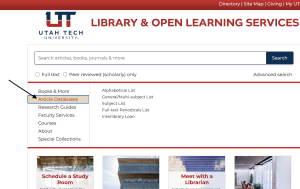
Step 3: Select the option that best aligns with your research interests –consider General/Multi-subject or Subject List first as they are typically more user-friendly.
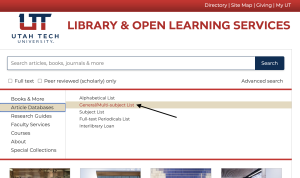
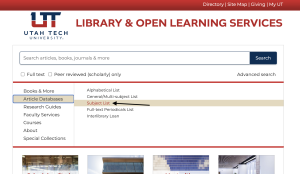
Searching on the Databases
Step 1: Read through the descriptions of each database, and select one that best aligns with your research interests.
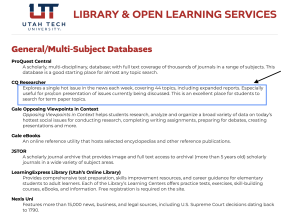
Step 2: Locate the “Advanced Search” option. This will provide you with more options for refining your search.
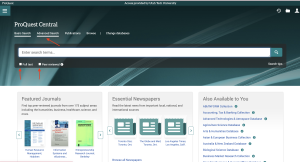
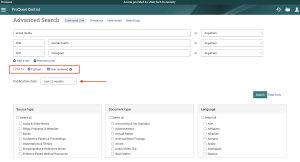
Tip: Click the “Peer Reviewed” (sometimes called “Scholarly”) and “Full Text” boxes. This will guarantee that all of the search results you receive are scholarly sources and you can read the article in its entirety, not just the abstract or summary.
Step 3: Play around with relevant search terms and Boolean operators.
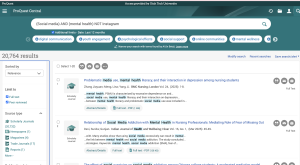
More on Library Databases
